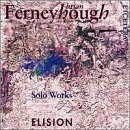| All Artists: Brian Ferneyhough, Elision Title: Brian Ferneyhough: Solo Works Members Wishing: 1 Total Copies: 0 Label: Etcetera Original Release Date: 3/22/2004 Release Date: 3/22/2004 Genre: Classical Styles: Chamber Music, Historical Periods, Classical (c.1770-1830), Instruments, Electronic, Reeds & Winds, Strings Number of Discs: 1 SwapaCD Credits: 1 UPC: 789368790821 |
Search - Brian Ferneyhough, Elision :: Brian Ferneyhough: Solo Works
 | Brian Ferneyhough, Elision Brian Ferneyhough: Solo Works Genre: Classical
|
Larger Image |
CD Details |
CD ReviewsTimbral particles of elegance and complexity scarecrow | Chicago, Illinois United States | 08/05/2001 (5 out of 5 stars) "Kurze Schatten II utilizes Walter Benjamin's essay in his Illuminations,and scours the conceptual metaphorical references one which bears fruit and leads toward a situation where the actual writing of the musical work becomes an arduous journey, like through a labyrinth. What this means is finding a situation which makes for something interesting to hear, as well as a conceptual frame that helps resolve the set of creative problems, like here writing for the acoustic guitar is a challenge. The challenge begins with the somewhat gestural limitations for someone of Ferneyhough's artistic demeanor, that of writing music at the extremes of impacted expressionistic moments, deeply rich and variegated in texture, resonance,timbre,rhythm,structure and concept. But borrowing from Benjamin's essay lends more the overall structural frame here. Incidentally there is no Kurze Schatten I. Benjamin's essay makes reference to the light, the illuminations of the sun, in a metaphorical like associations of shadows,hence the title, where light cast over say a city, or something the human eye can see transforms ever so slightly until Noon where shadows are eradicated. Ferneyhough saw this as a way of structuring this work in the amount of light or for music,then resonance which is "allowed" to escape or become to be perceived. He also begins the work with the retuning of the guitars strings(scordatura), until as such point where these tunings fairly return the guitar to its original resonant constitutions. The result is mutiplicity of discreet microscopic like timbres which inhabit this metaphorical space until Noon. For the guitar,the large timbral pallette, almost too countless to name, but for instance, harmonics with plucked strings, tapping the instruments body allowing only certain tones to resonate.snapping the strings against the fingerboard(Bartok pizz).Bone Alphabet produces similar result yet with an entirely different approach. The work has a base functional premise,in that a percussionist asked Ferneyhough for a work to travel with,thereby setting the limitations on travel, and availability for small transport. So the work is written for seven percussion instruments of the performers choosing. Here wood blocks, a snare drum, a tenor drum, cowbell, I heard. The work proceeds as around a cantus firmus like rhythm, that seems to be reiterated, but with the inherent complexity of language it is barely discernable. The result is an elegant way, with very gently soft rolls on for instance the woodblock, a fairly disarming almost childlike timbre. The work is like examining sound/timbre under a microscope. I was carried away unpretenciously in the works beauty. The various Time and Motion studies are early works, where Ferneyhough spent his creativity on the focus of solo timbre."
|

 Track Listings (11) - Disc #1
Track Listings (11) - Disc #1